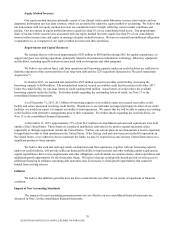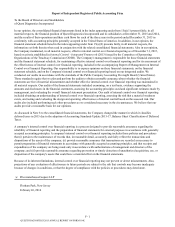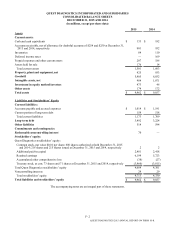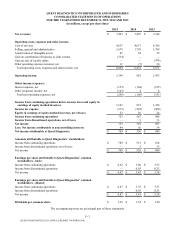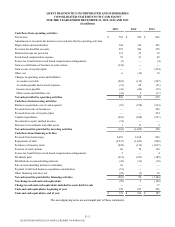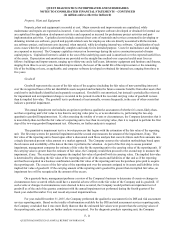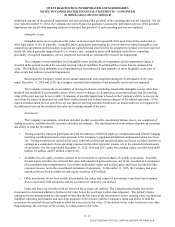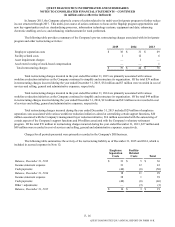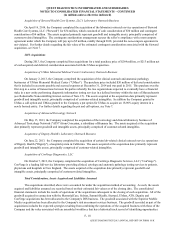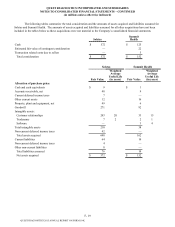Quest Diagnostics 2015 Annual Report Download - page 84
Download and view the complete annual report
Please find page 84 of the 2015 Quest Diagnostics annual report below. You can navigate through the pages in the report by either clicking on the pages listed below, or by using the keyword search tool below to find specific information within the annual report.QUEST DIAGNOSTICS INCORPORATED AND SUBSIDIARIES
NOTES TO CONSOLIDATED FINANCIAL STATEMENTS – CONTINUED
(in millions unless otherwise indicated)
F- 9
Taxes on Income
The provision for income taxes represents income taxes paid or payable for the current year plus the change in
deferred taxes during the year. Current and deferred income taxes are measured based on the tax laws that are enacted as of the
balance sheet date of the relevant reporting period. Deferred tax assets and liabilities are recognized for the expected future tax
consequences of differences between the carrying amounts of assets and liabilities and their respective tax bases using tax rates
in effect for the year in which the differences are expected to reverse. A valuation allowance is provided when it is more likely
than not that some portion or all of the deferred tax assets will not be realized. The effect on deferred tax assets and liabilities
of a change in tax rates is recognized in income in the period when the change is enacted. Tax benefits from uncertain tax
positions are recognized only if the tax position is more likely than not to be sustained upon examination by taxing authorities
based on the technical merits of the position.
Earnings Per Share
The Company's unvested restricted stock units that contain non-forfeitable rights to dividends are participating
securities and, therefore, are included in the earnings allocation in computing earnings per share using the two-class method.
Basic earnings per common share is calculated by dividing net income, adjusted for earnings allocated to participating
securities, by the weighted average number of common shares outstanding. Diluted earnings per common share is calculated
by dividing net income, adjusted for earnings allocated to participating securities, by the weighted average number of common
shares outstanding after giving effect to all potentially dilutive common shares outstanding during the period. Potentially
dilutive common shares include the dilutive effect of outstanding stock options and performance share units granted under the
Company's Amended and Restated Employee Long-Term Incentive Plan (“ELTIP”) and its Amended and Restated Non-
Employee Director Long-Term Incentive Plan (“DLTIP”). Earnings allocable to participating securities include the portion of
dividends declared as well as the portion of undistributed earnings during the period allocable to participating securities.
Stock-Based Compensation
The Company records stock-based compensation as a charge to earnings net of the estimated impact of forfeited
awards. As such, the Company recognizes stock-based compensation cost only for those stock-based awards that are estimated
to ultimately vest over their requisite service period, based on the vesting provisions of the individual grants. The cumulative
effect on current and prior periods of a change in the estimated forfeiture rate is recognized as compensation cost in earnings in
the period of the change. The terms of the Company's performance share unit awards allow the recipients of such awards to
earn a variable number of shares based on the achievement of the performance goals specified in the awards. Stock-based
compensation expense associated with performance share units is recognized based on management's best estimates of the
achievement of the performance goals specified in such awards and the resulting number of shares that will be earned. The
cumulative effect on current and prior periods of a change in the estimated number of performance share units expected to be
earned is recognized as compensation cost in earnings in the period of the change. The Company recognizes stock-based
compensation expense related to the Company's Amended Employee Stock Purchase Plan (“ESPP”) based on the 15% discount
at purchase. For further details regarding stock-based compensation, see Note 16.
Fair Value Measurements
The Company determines fair value measurements used in its consolidated financial statements based upon the exit
price that would be received to sell an asset or paid to transfer a liability in an orderly transaction between market participants
exclusive of any transaction costs, as determined by either the principal market or the most advantageous market.
Inputs used in the valuation techniques to derive fair values are classified based on a three-level hierarchy. The basis
for fair value measurements for each level within the hierarchy is described below with Level 1 having the highest priority and
Level 3 having the lowest.
Level 1: Quoted prices in active markets for identical assets or liabilities.
Level 2: Quoted prices for similar assets or liabilities in active markets; quoted prices for identical or similar
instruments in markets that are not active; and model-derived valuations in which all significant inputs are
observable in active markets.
Level 3: Valuations derived from valuation techniques in which one or more significant inputs are unobservable.
QUEST DIAGNOSTICS 2015 ANNUAL REPORT ON FORM 10-K


